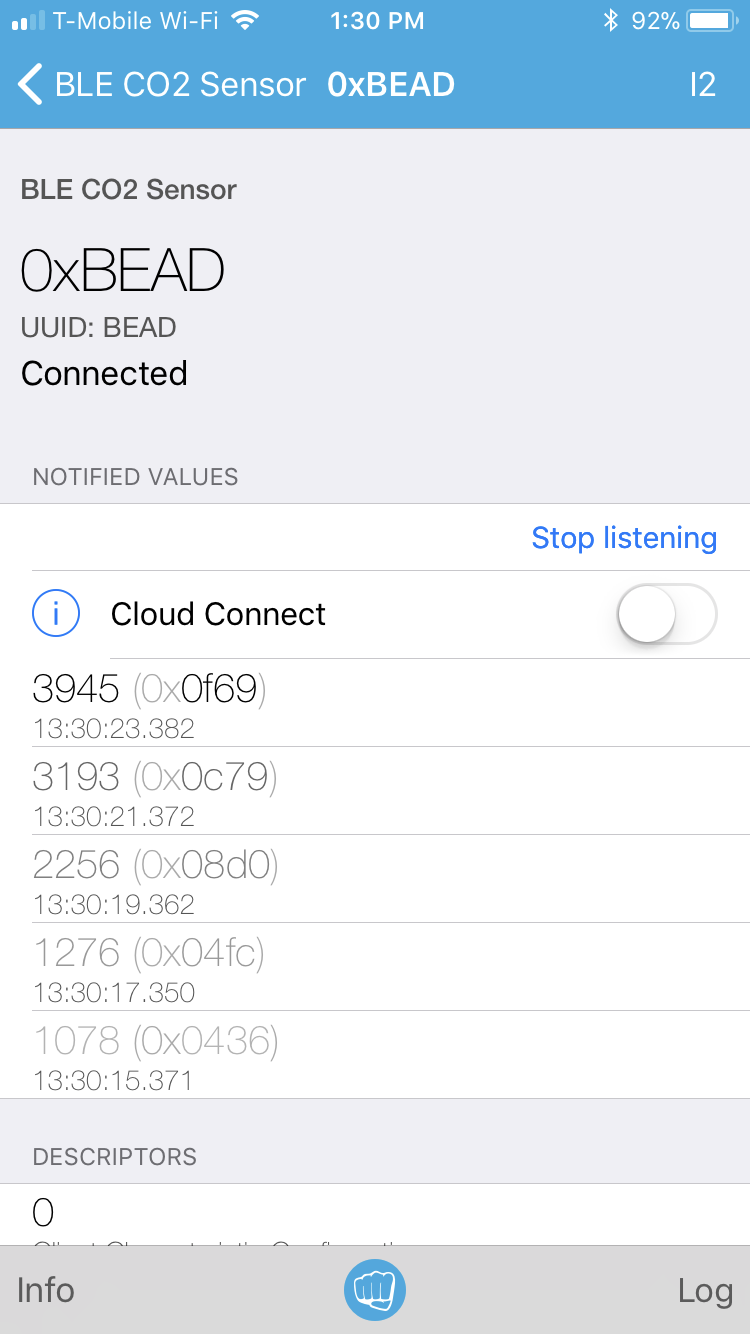Air Quality Sensor Project via Bluetooth¶
This is a follow-on project to the Basic Air Quality Sensor project; so it is assumed that you have worked through that project and have your CO2 sensor working properly with your nRF52DK board.
So let’s get started making this thing Bluetooth enabled!
Add Bluetooth GATT Services¶
Since we already built the previous demo on the bluetooth peripheral basic app most of the Bluetooth plumbing has already been taken care of for us. What’s left is for us to add the required GATT services for advertising the Carbon Dioxide sensor so that other devices can get those values.
First, we’ll define the GATT Services in apps/air_quality/src/bleprph.h. Be sure to include the header files as well.
#include "host/ble_hs.h"
#include "host/ble_uuid.h"
....
/* Sensor Data */
/* e761d2af-1c15-4fa7-af80-b5729002b340 */
static const ble_uuid128_t gatt_svr_svc_co2_uuid =
BLE_UUID128_INIT(0x40, 0xb3, 0x20, 0x90, 0x72, 0xb5, 0x80, 0xaf,
0xa7, 0x4f, 0x15, 0x1c, 0xaf, 0xd2, 0x61, 0xe7);
#define CO2_SNS_TYPE 0xDEAD
#define CO2_SNS_STRING "SenseAir K30 CO2 Sensor"
#define CO2_SNS_VAL 0xBEAD
uint16_t gatt_co2_val;
You can use any hex values you choose for the sensor type and sensor values, and you can even forget the sensor type and sensor string definitions altogether but they make the results look nice in our Bluetooth App for Mac OS X and iOS.
Next we’ll add those services to apps/air_quality/src/gatt_svr.c.
static int
gatt_svr_sns_access(uint16_t conn_handle, uint16_t attr_handle,
struct ble_gatt_access_ctxt *ctxt,
void *arg);
static uint16_t gatt_co2_val_len;
Make sure it is added as primary service.
static const struct ble_gatt_svc_def gatt_svr_svcs[] = {
{
/*** Service: Security test. */
.type = BLE_GATT_SVC_TYPE_PRIMARY,
.uuid = &gatt_svr_svc_sec_test_uuid.u,
.characteristics = (struct ble_gatt_chr_def[]) { {
/*** Characteristic: Random number generator. */
.uuid = &gatt_svr_chr_sec_test_rand_uuid.u,
.access_cb = gatt_svr_chr_access_sec_test,
.flags = BLE_GATT_CHR_F_READ | BLE_GATT_CHR_F_READ_ENC,
}, {
/*** Characteristic: Static value. */
.uuid = &gatt_svr_chr_sec_test_static_uuid,.u
.access_cb = gatt_svr_chr_access_sec_test,
.flags = BLE_GATT_CHR_F_READ |
BLE_GATT_CHR_F_WRITE | BLE_GATT_CHR_F_WRITE_ENC,
}, {
0, /* No more characteristics in this service. */
} },
},
{
/*** CO2 Level Notification Service. */
.type = BLE_GATT_SVC_TYPE_PRIMARY,
.uuid = &gatt_svr_svc_co2_uuid.u,
.characteristics = (struct ble_gatt_chr_def[]) { {
.uuid = BLE_UUID16_DECLARE(CO2_SNS_TYPE),
.access_cb = gatt_svr_sns_access,
.flags = BLE_GATT_CHR_F_READ,
}, {
.uuid = BLE_UUID16_DECLARE(CO2_SNS_VAL),
.access_cb = gatt_svr_sns_access,
.flags = BLE_GATT_CHR_F_NOTIFY,
}, {
0, /* No more characteristics in this service. */
} },
},
{
0, /* No more services. */
},
};
Next we need to tell the GATT Server how to handle requests for CO2 readings :
static int
gatt_svr_sns_access(uint16_t conn_handle, uint16_t attr_handle,
struct ble_gatt_access_ctxt *ctxt,
void *arg)
{
uint16_t uuid16;
int rc;
uuid16 = ble_uuid_u16(ctxt->chr->uuid);
switch (uuid16) {
case CO2_SNS_TYPE:
assert(ctxt->op == BLE_GATT_ACCESS_OP_READ_CHR);
rc = os_mbuf_append(ctxt->om, CO2_SNS_STRING, sizeof CO2_SNS_STRING);
BLEPRPH_LOG(INFO, "CO2 SENSOR TYPE READ: %s\n", CO2_SNS_STRING);
return rc == 0 ? 0 : BLE_ATT_ERR_INSUFFICIENT_RES;
case CO2_SNS_VAL:
if (ctxt->op == BLE_GATT_ACCESS_OP_WRITE_CHR) {
rc = gatt_svr_chr_write(ctxt->om, 0,
sizeof gatt_co2_val,
&gatt_co2_val,
&gatt_co2_val_len);
return rc;
} else if (ctxt->op == BLE_GATT_ACCESS_OP_READ_CHR) {
rc = os_mbuf_append(ctxt->om, &gatt_co2_val,
sizeof gatt_co2_val);
return rc == 0 ? 0 : BLE_ATT_ERR_INSUFFICIENT_RES;
}
default:
assert(0);
return BLE_ATT_ERR_UNLIKELY;
}
}
Now it’s time to go into our apps/air_quality/src/main.c and change how we read CO2 readings and respond to requests.
We’ll need a task handler with an event queue for the CO2 readings.
/* CO2 Task settings */
#define CO2_TASK_PRIO 128
#define CO2_STACK_SIZE (OS_STACK_ALIGN(336))
struct os_eventq co2_evq;
struct os_task co2_task;
bssnz_t os_stack_t co2_stack[CO2_STACK_SIZE];
And of course we’ll need to go to our main() and do all the standard task and event setup we normally do by adding the following:
/* Initialize sensor eventq */
os_eventq_init(&co2_evq);
/* Create the CO2 reader task.
* All sensor reading operations are performed in this task.
*/
os_task_init(&co2_task, "sensor", co2_task_handler,
NULL, CO2_TASK_PRIO, OS_WAIT_FOREVER,
co2_stack, CO2_STACK_SIZE);
We’ll also need to add a task handler – since we initialized it above:
/**
* Event loop for the sensor task.
*/
static void
co2_task_handler(void *unused)
{
while (1) {
co2_read_event();
/* Wait 2 second */
os_time_delay(OS_TICKS_PER_SEC * 2);
}
}
And finally, we’ll take care of that co2_read_event() function:
int
co2_read_event(void)
{
int value;
enum senseair_read_type type = SENSEAIR_CO2;
uint16_t chr_val_handle;
int rc;
value = senseair_read(type);
if (value >= 0) {
console_printf("Got %d\n", value);
} else {
console_printf("Error while reading: %d\n", value);
goto err;
}
gatt_co2_val = value;
rc = ble_gatts_find_chr(&gatt_svr_svc_co2_uuid.u, BLE_UUID16_DECLARE(CO2_SNS_VAL), NULL, &chr_val_handle);
assert(rc == 0);
ble_gatts_chr_updated(chr_val_handle);
return (0);
err:
return (rc);
}
This one simply reads and updates the CO2 value and sends that over BLE to any connected clients instead.
We can now build, create-image and load the app onto our nRF52DK board, and then connect and see the updated values! To view the results over Bluetooth, you can use LightBlue or any other application that can connect to, and read, Bluetooth data. By default, the device will show up as nimble-bleprph, since we used the bleprph app as our template. I’ve changed mine to something a bit more applicable: BLE CO2 Sensor.

LightBlue app connected to BLE CO2 Sensor¶
Congratulations!!
